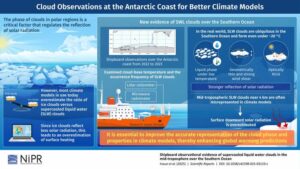A research team from the National Institute of Polar Research, Japan, has conducted an extensive four-month study of cloud behavior over the Southern Ocean in Antarctica. Their findings, published online in Scientific Reports on May 28, 2025, provide observational evidence about supercooled liquid water (SLW) clouds that could reportedly revolutionize how climate models simulate polar weather systems.
The study was supported by the Science Program of the Japanese Antarctic Research Expedition (JARE) as Prioritized Research Projects (AJ1005 and AJ1003), JSPS Kakenhi (grant numbers: JP23H00523 and JP24H02341), and the National Institute of Polar Research (NIPR) through research projects KP-402 and KC-401.
Studying supercooled liquid water clouds
To conduct its investigation, the team embarked on a research cruise aboard the research vessel Shirase, traversing the Southern Ocean for four months from December 2022 to March 2023. The ship was equipped with a lidar ceilometer and a microwave radiometer.
Through meticulous observation and analysis, the researchers revealed a dominance of SLW clouds in the mid-troposphere, typically existing as thin layers less than 200m thick. These clouds constituted about 95% of the observed mid-level clouds, even when cloud-base temperatures dropped below -25°C. Since these clouds are optically thick, they reflect a lot of incoming shortwave radiation from the sun. The team also showed that the inaccurate portrayal of these mid-tropospheric clouds at the altitude of phase transitions in the climate models results in an overestimation of net downward radiation reaching the surface.

Polar climate model
Taken together, these findings challenge previous assumptions and provide insights for accurately modeling the polar climate. “Our observational results provide ideas for improving existing models because they have difficulty reproducing SLW clouds instead of ice clouds,” noted Prof. Jun Inoue. The team’s analysis of air mass movements revealed that persistent SLW clouds are primarily maintained by local atmospheric circulation during calm periods, making them crucial for understanding regional energy balance.
According to the team, the results of this work have profound implications for climate science and global warming predictions. An improved representation of SLW clouds is projected to help resolve longstanding discrepancies in climate models, leading to more reliable projections of ice-sheet melting, sea-level rise and regional climate changes that would ultimately affect billions of people worldwide.



